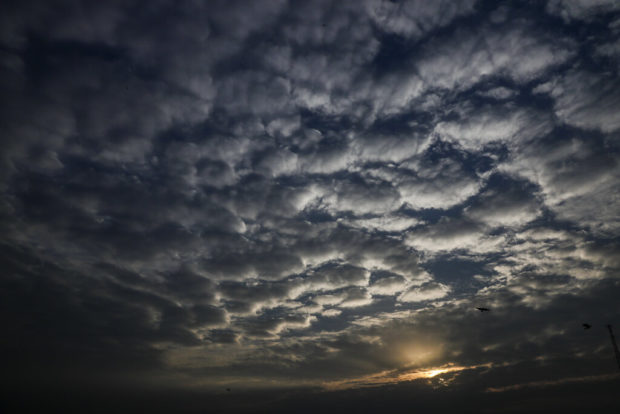India, Bangladesh brace for cyclone in the midst of pandemic
NEW DELHI — A strong cyclone was moving toward India and Bangladesh on Tuesday as authorities were trying to evacuate millions of people while maintaining social distancing.

Sun sets behind a patterned cloud formed over the city in Kolkata, West Bengal state, India, Monday, May 18, 2020. A cyclonic storm ‘Amphan’ has intensified into a super cyclone over the Bay of Bengal and expected a landfall near Sundarbans, south of Kolkata, on May 19 evening. A red alert has been initiated to sea bound fishermen and disaster management teams started evacuating villagers from the sea front. AP Photo/Bikas Das
Amphan is expected to make landfall on Wednesday morning, and forecasters warned of extensive damage from high winds, heavy rainfall, tidal waves and some flooding in crowded cities like Kolkata.
The cyclone had winds of 220-230 kilometers per hour (136 -142 miles per hour) and is forecast to weaken before landfall around India’s West Bengal state and Bangladesh.
It is the second super cyclone on record that has formed over the Bay of Bengal, said Mrutyunjay Mohapatra, India’s meteorological chief. The first of that classification was the devastating 1999 cyclone in Odisha state that left nearly 10,000 dead.
“This type of cyclone can be disastrous…It is completely unsafe,” Mohapatra said.
Amphan’s winds are whirling 700 kilometers (435 miles) from its eye as it approaches land. It’s forecast to pass between the seaside resort town of Digha in India’s West Bengal state and Hatiya Island in Bangladesh with a weaker wind speed of 165 to 175 kph (102-108 mph).
Article continues after this advertisementSeveral districts of West Bengal will be most impacted by the storm, said Mohapatra, warning of uprooted trees, electric poles and damage to old or temporary housing.
Article continues after this advertisementFlooding was a risk in Kolkata due to crowding and poor drainage and the storm surge would raise river levels in the Bengal delta, he said.
The Meteorological Department in the Bangladesh said the cyclone could flood vast spans in southwestern and southern Bangladesh from tidal waves 4 to 5 feet higher than normal, along with heavy rainfall and high wind speeds.
Bangladesh authorities have asked maritime ports to maintain danger signal up to 7 while 19 coastal districts and their offshore islands were also at the risk of severe destruction. Fishing trawlers and boats in Bay of Bengal have been asked to take shelter until further notice.
After reaching land, the cyclone is expected to move away fast and weaken by Thursday.
The eye of the storm is likely to pass through the Sunderban mangrove forests, one of the largest single tracts of mangrove forests in the world. The forests are likely to absorb some impact of the cyclone, officials said.
Junior Minister for Disaster Management and Relief Enamur Rahman in Bangladesh said he ordered local authorities to prepare thousands of cyclone shelters and makeshift structures to take more than 5 million people to safety before the cyclone crosses the region. The evacuation has not started yet.
For more news about the novel coronavirus click here.
What you need to know about Coronavirus.
For more information on COVID-19, call the DOH Hotline: (02) 86517800 local 1149/1150.
The Inquirer Foundation supports our healthcare frontliners and is still accepting cash donations to be deposited at Banco de Oro (BDO) current account #007960018860 or donate through PayMaya using this link.